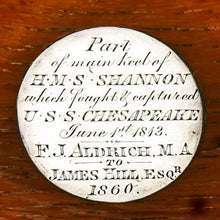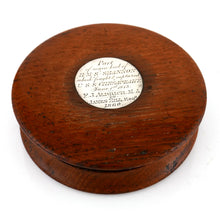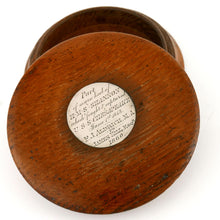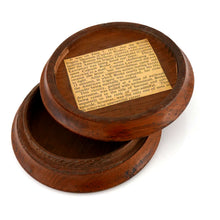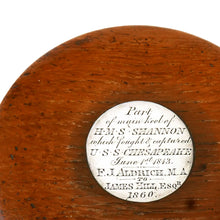H.M.S. Shannon Snuff Box
Adding product to your cart
Diameter: 10.1cm (3.9in)
Turned oak circular box, the lift off lid inset with a central silver plaque inscribed ‘Part / of the main deck of / H.M.S. Shannon / which fought & captured / U.S.S. Chesapeake / June 1st 1813 / F.J. Aldrich M.A. / to / James Hill Esq.r / 1860.’
The fight between HMS Shannon and the USS Chesapeake off Boston on 1 June 1813 was one of the most famous single ship actions of the Golden Age of Sail. Shannon, a 38-gun Leda class frigate, was broken up in 1859 whence a number of souvenirs were produced from her timbers. F.J. Aldrich of the inscription was the Rev. Frederick James Aldrich-Blake, M.A. (1824-1904). Between 1859 and 1862 he was a curate of St. Martin’s-in-the-Fields, Westminster. In 1861 he was a lodger at 6 Northumberland Street, Charing Cross, as shown on the census return of that year. Also lodging at 6 Northumberland Street was Trafalgar veteran George Rose Sartorious, later Admiral of the Fleet Sir George Sartorious, G.C.B., R.N. (1790-1885). According to an article written 1887 for the New Zealand newspaper Southland Times, Admiral Sartorious and Admiral of the Fleet Sir Provo Wallis, G.C.B., R.N. (1791-1892) of Shannon fame were onetime shipmates.
Read more
‘The nonagenariun admiral goes out into the corridor and brings in his old messmate George Sartorious’s admirable picture of the hoisting of the Union Jack of the Shannon over the star-spangled banner of the Chesapeake, which he shows you, as he tells you in simple language the tale of the 1st of June, 1813. "It was a time of disaster and anxiety. We had been losing ships in all directions, when Capt. Broke sent in his formal challenge to Captain Lawrence by a fishing-boat. The American Nelson signified his acceptance of it by firing a gun, and hoisting a large flag bearing the device ‘Free Trade and Sailors' Rights.’ Lawrence was sure of winning. A dinner was prepared for the prisoners; there was a plentiful supply of handcuffs on deck and several merchant-vessels came out to witness our discomfiture. We put off some six miles with three ensigns flying, and she bore down upon us over the smooth sea in gallant style. It was the death-grapple of two Kilkenny cats. They cheered and fired. We replied simultaneously with our shot. Three broadsides only were delivered, and eleven minutes saw the end of the fight. The two vessels became entangled. Broke shouted for all who could to follow him, and when the ships separated he signalled that he was securely in possession. Every officer on the Chesapeake down to the officiating chaplain was slain; the courageous Lawrence, shot through the body, died four days afterwards in his cabin; Broke was cut down and dangerously wounded by treachery; and Watt, our first lieutenant was killed by a bullet from tho foretop. It thus came to pass that, at the age of two-and-twenty, I took command of the Shannon, put my junior Falkiner, in charge of the prize, placed their own fetters on the wrists of our prisoners, and we set sail for Halifax. It was Sunday evening when we arrived there, and everybody was in church, We were concealed by a fog till close to the harbour; the yards of both ships were manned, and the British flag floated proudly over the American ensign. The rumour of our coming spread like wildfire …’
Interestingly the Southland Times reporter noticed in Provo Wallis ’s Sussex home, some 74 years after the engagement, ’a snuff box made out the timber from Chesapeake on the narrow grey marble mantelshelf’, illustrating how veterans themselves valued such souvenirs made from the timbers of celebrated warships. The former owner of the present snuff box, the Rev. Aldrich, was the son of Robert Aldrich, gent., of Erwarton, Suffolk. He was educated at Cambridge and ordained at Ely in 1854. Later he was rector and patron of English Bicknor, Gloucestershire. He assumed the additional name Blake in 1863. Died at Welsh Bicknor in 1904. Another Shannon relic, a ‘Block of oak’ with a brass plaque detailing its provenance resides in the Royal Collection
Refs:
Southland Times 30.9.1887 article ‘An Ancient Naval Hero’
‘The rival frigates’, Ann V Gunn, The British Art Journal, Vol. 7, No. 2 (Autumn 2006), pp. 101-114






